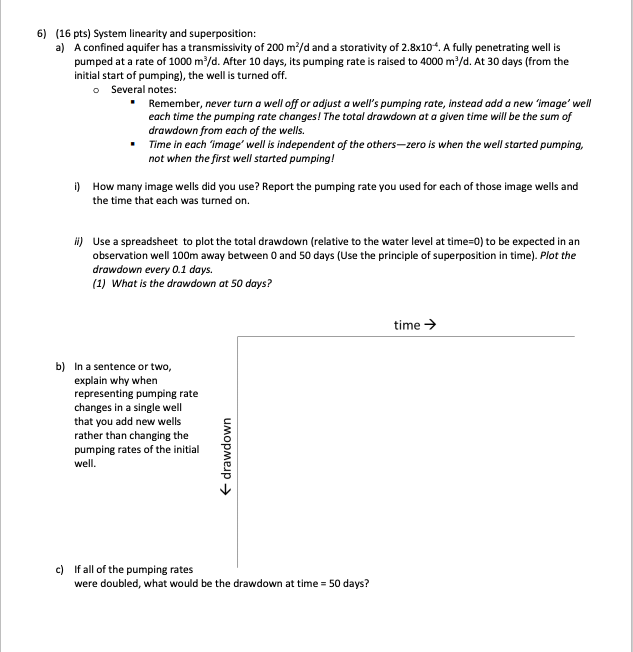
6) (16 pts) System linearity and superposition: a) A confined aquifer has a transmissivity of 200 m/d and a storativity of 2.8x104. A fully penetrating well is pumped at a rate of 1000 m/d. After 10 days, its pumping rate is raised to 4000 m/d. At 30 days (from the initial start of pumping), the well is turned off. Several notes: Remember, never turn a well off or adjust a well's pumping rate, instead add a new 'image' well each time the pumping rate changes! The total drawdown at a given time will be the sum of drawdown from each of the wells. Time in each 'image' well is independent of the others-zero is when the well started pumping, not when the first well started pumping! i) How many image wells did you use? Report the pumping rate you used for each of those image wells and the time that each was turned on. ii) Use a spreadsheet to plot the total drawdown (relative to the water level at time=0) to be expected in an observation well 100m away between 0 and 50 days (Use the principle of superposition in time). Plot the drawdown every 0.1 days. (1) What is the drawdown at 50 days? time b) In a sentence or two explain why when representing pumping rate changes in a single well that you add new wells rather than changing the pumping rates of the initial well. drawdown c) If all of the pumping rates were doubled, what would be the drawdown at time = 50 days? 6) (16 pts) System linearity and superposition: a) A confined aquifer has a transmissivity of 200 m/d and a storativity of 2.8x104. A fully penetrating well is pumped at a rate of 1000 m/d. After 10 days, its pumping rate is raised to 4000 m/d. At 30 days (from the initial start of pumping), the well is turned off. Several notes: Remember, never turn a well off or adjust a well's pumping rate, instead add a new 'image' well each time the pumping rate changes! The total drawdown at a given time will be the sum of drawdown from each of the wells. Time in each 'image' well is independent of the others-zero is when the well started pumping, not when the first well started pumping! i) How many image wells did you use? Report the pumping rate you used for each of those image wells and the time that each was turned on. ii) Use a spreadsheet to plot the total drawdown (relative to the water level at time=0) to be expected in an observation well 100m away between 0 and 50 days (Use the principle of superposition in time). Plot the drawdown every 0.1 days. (1) What is the drawdown at 50 days? time b) In a sentence or two explain why when representing pumping rate changes in a single well that you add new wells rather than changing the pumping rates of the initial well. drawdown c) If all of the pumping rates were doubled, what would be the drawdown at time = 50 days







